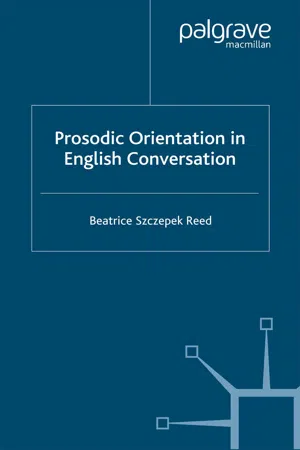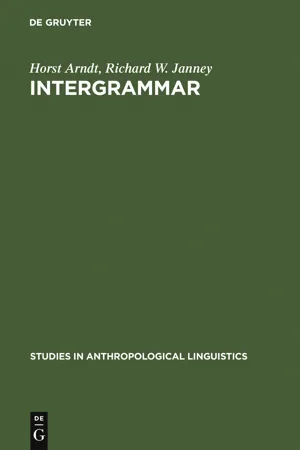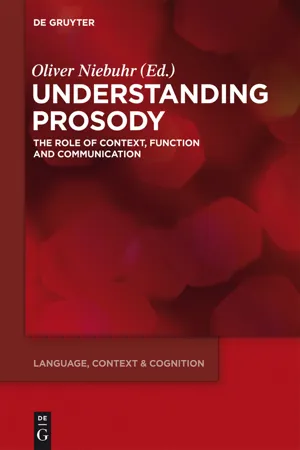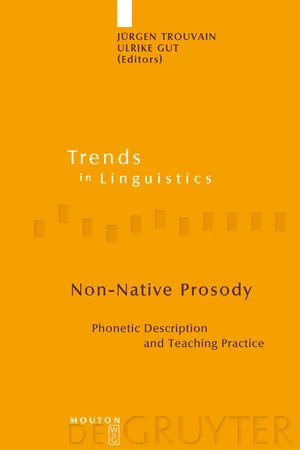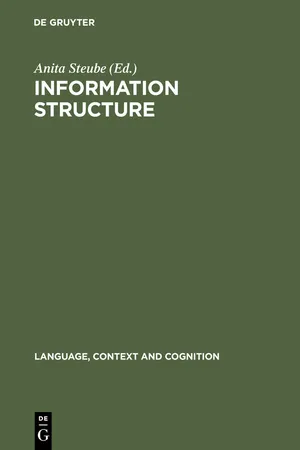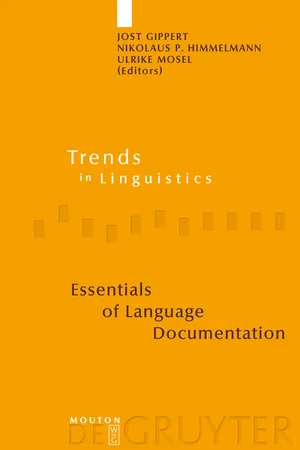Languages & Linguistics
Prosody
Prosody refers to the rhythm, intonation, and stress patterns in language. It encompasses the musical and expressive aspects of speech, including pitch, tempo, and pauses. In linguistics, prosody plays a crucial role in conveying meaning, emotion, and emphasis, and is studied to understand how these elements contribute to communication and interpretation.
Written by Perlego with AI-assistance
Related key terms
1 of 5
11 Key excerpts on "Prosody"
- Brenda Nicodemus(Author)
- 2009(Publication Date)
- Gallaudet University Press(Publisher)
Prosody in Spoken Languages: An Overview Spoken language can be analyzed as having a hierarchical structure, with sounds as the smallest perceptible unit. Sounds can be grouped into syl-lables, which are assembled into words. These words are then grouped with adjacent words to create phrases of varying lengths, which may be grouped to form sentences and even longer strings of discourse. These various levels of spoken language are characterized by patterns of rhythm, timing, volume, and intonation—collectively known as Prosody. A universally accepted definition of Prosody has been elusive. Shattuck-Hufnagel and Turk (1996) state that a satisfactory definition of Prosody must include both a description of the relevant acoustic patterns of lan-guage as well as the higher-level constituents that account for the pat-terns. Crystal (1969) defines Prosody as sets of phonetic properties, such as frequency (f0), duration, amplitude, quality, and reduction, which have variable relationships with their co-occurring segments. At one end is an abstract definition of Prosody that is not necessarily linked to its expres-sion and, at the other, a listing of the measurable suprasegmental features of language. Cutler et al. (1997) propose a definition that encompasses What Is Prosody? : 15 both perspectives by defining Prosody as “an abstract structure coupled to a particular type of realization” (p. 142). Prosody and syntax are bound together in the linguistic system. For example, Prosody regularly marks certain syntactic structures, such as parentheticals, tags, nonrestrictive relatives, and appositives. Another Prosody-syntax link may be found in the role of Prosody in disambiguat-ing sentences that may be understood in more than one way (Allbritton, McKoon, & Ratcliff, 1996; Lehiste, 1972; Price, Ostendorf, Shattuck-Hafnagel, & Fong, 1991; Streeter, 1978).- eBook - ePub
Phonology in English Language Teaching
An International Approach
- Martha C. Pennington(Author)
- 2014(Publication Date)
- Routledge(Publisher)
It is then a short step to phonological markers and stereotypes which indicate meaning that can override and contradict the lexical meaning of the words and can therefore be used to intentionally deceive or confuse. Thus, when a person's voice says one thing and his/her words say another, we tend to believe the voice, not the words. In addition, when certain voice qualities are regularly associated with certain social roles or socially defined groups, they are easily recognized by people for what they symbolize and so can be used to parody or to ridicule.From the foregoing discussion, it can be concluded that Prosody – taken as a complex of voice quality, intonation, rhythm, stress and phonological fluency – fulfils a wide range of communicative functions. In English, Prosody functions as:(1) a direct, iconic indicator of the significance of information (e.g. as of greater or lesser importance);(2) an emblematic indicator of a grammatical pattern (e.g. statement vs. question);(3) a symptom of an emotional state or attitude (e.g. uncertainty vs. certainty);(4) a signal of a certain stance or role taken by the speaker (e.g. condescension or authority);(5) a marker of a socially or geographically defined group (e.g. speakers from a certain region or ethnic group);(6) a symbol of a particular social role (e.g. femininity vs. masculinity);(7) a defining characteristic of a particular type of interaction (e.g. “adult talk” vs. “baby talk");(8) a representation, whether genuine or not, of a speaker characteristic, condition or role;(9) an index of a speaker's individual identity.In sum, the dividing lines between Prosody in its function as marking out information units and as communicating various types of expressive and social meanings are by no means clearcut. The range of meanings of Prosody, as summarized in Figure 4.7 , can be described as a continuum from presentational, in which the relationship between sound and meaning is simple and direct, to representational - eBook - PDF
- Beatrice Szczepek Reed(Author)
- 2006(Publication Date)
- Palgrave Macmillan(Publisher)
So far, the collaborative potential of Prosody has 2 Prosodic Orientation in English Conversation been investigated only with respect to rhythm (Couper-Kuhlen 1993; Auer et al. 1999), and pitch range employed for quoting and mimicry (Couper-Kuhlen 1996). This book encompasses orientation in all other prosodic parameters. The following chapters attempt to show that Prosody is treated by interactants as ‘common property’, interrelated with other speakers’ prosodic designs. The data under analysis are every- day conversations by native speakers of close-to-standard British or US American varieties, which were recorded during face-to-face interactions, telephone conversations and radio broadcasts. Preceding the analysis of the phenomenon, this chapter outlines some basic claims about conver- sational Prosody. The next section provides a brief definition of ‘Prosody’ as the object of study; subsequently, four previous approaches to Prosody are presented; the fourth section introduces the approach to the Prosody of spoken interaction employed in this book; and the fifth section describes the linguistic units most relevant for the analysis of Prosody in conversation. The chapter ends with information about the data corpus and a preview over the remaining chapters. Prosody defined In most phonological traditions, Prosody is understood to comprise the ‘suprasegmental’ elements of speech: pitch is realized in the form of intonation and pitch register; loudness is realized in the form of stress on single syllables and loudness over longer stretches of talk; time is realized in the form of duration, tempo, speech rate, rhythm and pause. 1 Pitch is the auditory impression of speech sounds as located on a scale between ‘high’ and ‘low’. It corresponds to the acoustic feature of the frequency of vibration of the vocal folds, it is measured in Hertz values and it is realized as a pitch curve in an acoustic analysis. - eBook - PDF
InterGrammar
Toward an Integrative Model of Verbal, Prosodic and Kinesic Choices in Speech
- Horst Arndt, Richard W. Janney(Authors)
- 2011(Publication Date)
- De Gruyter Mouton(Publisher)
In the field of prosodies, this means: (1) explaining what sorts of prosodic information speakers rely on in interpreting one another's thoughts, feelings and intentions, and (2) accounting systematically for how prosodic and other types of communicative behavior interact and convey interpretable impres-sions (cf. Gumperz 1982: 100 ff.). The difficulty with much modern work on the interpretation of prosodic cues is that there are few fixed points from which to generate descriptions and comparisons (cf. Crystal 1969: 294). Prosody, we said, is more gradient than discrete. Empirical studies show prosodic effects can be measured acoustically (cf. Klein 1980, 1982, 1985; Tropf 1985), but simple measurements of variations in pitch, loudness, pause-length and so on tell us little about how or what Prosody communicates in speech. 6.1 Prosody 237 The problem of ascribing generalized interpretive glosses to specific patterns of accentuation, intonation, and rhythm is increased by what McGregor (1982: 123) calls the relative absence of explicit criteria and an agreed semantic theory, and by the inability of most present prosodic models to take contextual dynamics into account. When we consider the range of prosodic effects a speaker can intentionally produce, and the range of meanings he may wish to communicate with these — not to mention the number of interpretations his listener may infer — it is clear that the selection of fixed prosodic interpretations is not a particularly useful starting point for an inter-pretive schema. Yet something of this sort stands behind most modern approaches to accounting for Prosody. - eBook - PDF
Sociophonetics
An Introduction
- Erik Thomas(Author)
- 2017(Publication Date)
- Red Globe Press(Publisher)
184 6.1 Diverse and full of opportunities Prosody encompasses a rather disparate collection of phenomena. Generally, it is taken to mean phonological or phonetic processes that aren’t part of the segmental phonology. They involve pitch (the perceptual analogue of F 0 fre-quency), timing of items larger than segments and/or, to some extent, loudness (realized as amplitude). They range from lexical processes such as tone and lexical stress to phenomena larger than words such as intonation. Even pauses can be considered part of Prosody. Of course, F 0 and timing also figure in some segmental distinctions. As we’ve seen in previous chapters, F 0 plays a supplementary role in the voicing distinction for consonants and for vowel height. The role of timing in segmen-tal distinctions is even better known. Timing is the primary factor distinguish-ing contrastive length, both for vowels and for consonants, and it is involved with the voicing distinction for consonants, with stop/fricative distinctions, and for tenseness and height distinctions among vowels (high vowels tend, on average, to be shorter than low vowels). There are numerous points of contact between prosodic and segmental variation, especially regarding lexical tone. As we’ll see, the distinction becomes murky when we consider prosodic rhythm as well. Prosodic variation is underexplored. As a result, it is fertile ground for inno-vative work and enterprising researchers. Leaving aside tone and lexical stress, there have been two major thrusts in studies of prosodic variation. One is in prosodic rhythm. This has to do with variations in the length of syllables or of the vocalic and/or consonantal portions of different syllables. It is convention-ally thought of by using the terms stress-timing and syllable-timing . Studies of variation in prosodic rhythm are incipient. To date, most of the discussion of prosodic rhythm has centred on methods of gauging it instead of applications to variation. - eBook - PDF
Understanding Prosody
The Role of Context, Function and Communication
- Oliver Niebuhr(Author)
- 2012(Publication Date)
- De Gruyter(Publisher)
In summary, this paper has made the following claims: – Prosodies are linguistic features that bind structures together within the speech of one or more individuals. – Prosodies are constructions: regular, socially conventional mappings between form and meaning. – Prosodies can be formalised as constraints over larger pieces of structure, relating information at various levels: lexical, syntactic, sequential, and the level of action. This understanding of Prosody gives linguists a way to understand phonetic detail, and gives conversation analysts a way to talk to linguists. 216 Richard Ogden 7 References Anderson, S.R. (1984): Phonology in the Twentieth Century . Chicago: Chicago University Press. Coleman, J.S. (1998): Phonological Representations: their names, forms and powers. Cambridge: Cambridge University Press. Couper-Kuhlen, E. and C.E. Ford (2004): Sound Patterns in Interaction. Amsterdam: John Benjamins. Couper-Kuhlen, E. (2007): Situated phonologies: Patterns of phonology in discourse contexts. In: M. Pennington (ed.): Phonology in Context (pp. 186-218). Palgrave: Macmillan. Couper-Kuhlen, E. (2009): Relatedness and timing in talk in interaction. In: D. Barth-Weingarten, N. Dehé, A. Wichmann (eds): Where Prosody Meets Pragmatics (pp. 257-276). Amsterdam: Benjamins. Firth, J.R. (1937): The Tongues of Men. London: Watts. In: Firth (1964): The Tongues of Men and Speech . London: Oxford University Press, 1–138. Firth, J.R. (1948): Sounds and Prosodies. Transactions of the Philological Society , 127–152. Firth, J.R. (1957): Papers in Linguistics 1934-1951 . Oxford: Oxford University Press. Haakana, M. (ms). Laughter in conversation: the case of ‘fake’ laughter. University of Helsinki, ms. Hawkins, S. (2003): Roles and representations of systematic fine phonetic detail in speech understanding. Journal of Phonetics 31 , 373–405. Henderson, E.J.A. (1949): Prosodies in Siamese. Asia major I ., 189-215 . - eBook - PDF
- Marnie Reed, John Levis, Marnie Reed, John M. Levis(Authors)
- 2015(Publication Date)
- Wiley-Blackwell(Publisher)
That is, only those pronunciation features should be taught that contribute to internationally intelligible speech, a suggestion that has inspired much debate (Levis 2005; Dziubalsak‐Kołaczyk and Przedlacka 2005). Jenkins makes her argument against the background of academic discussions of English as a global, rather than a regional language, and the consequences this has for language learning and teaching. It is possible to develop this argument further, and take not only intelligibility but the successful accomplishment of actions in interaction as the criterion for teaching and learning pronunciation features. Regarding Prosody, this argument is a particularly powerful one, given the flexible use of prosodic parameters by “native” speakers compared to segmental pronunciation features. In the following we explore these issues by looking at speech rhythm, a prosodic feature whose form varies widely across languages. While features such as loudness, voice quality, and even pitch may have certain universal applications due to their close relation to physical sound production, time‐related features such as syllable lengthening, stress, and rhythm have closer connections to the linguistic structures of each language. Speech rhythm: stress timing and syllable timing Rhythm is a feature of all languages, as all speech adheres to some form of regularity in its fluent organization of words and syllables. However, describing languages as rhythmic does not mean that speech in those languages is perfectly Pronunciation and the Analysis of Discourse 201 isochronous, that is, absolutely regular. Rhythm is very much a perceptive phenomenon, and listeners will hear regularity even if the placement of rhythmic beats deviates to some extent from perfect isochrony. Nevertheless, most speech shows some form of regularity, even if languages differ greatly in their rhythmic organization. - eBook - PDF
Non-Native Prosody
Phonetic Description and Teaching Practice
- Jürgen Trouvain, Ulrike Gut, Jürgen Trouvain, Ulrike Gut(Authors)
- 2008(Publication Date)
- De Gruyter Mouton(Publisher)
Section 3 illustrates the potential for exchange with examples from the area of stress, articulation rate, speech rhythm and intonation. In the last section, we will point out requirements and solutions for the mutual benefit of both groups. 4 Ulrike Gut, Jürgen Trouvain and William J. Barry 2. Theoretical and practical approaches to non-native Prosody The aim of theoretical research in the area of second language (L2) proso-dy, as in linguistics as a whole, is to develop descriptions in the form of models and theories with predictive power. Those models and theories are based on and tested by empirical research, that is on observations and mea-surements of non-native speech, and are modified according to these obser-vations. A rich choice of research methods exists which vary along the lines of the type of language data that is analysed (experimental data or sponta-neous data) and the analysis method (e.g. qualitative versus quantitative; auditory or instrumental). Typically, speech elicited from non-native spea-kers in closely controlled conditions is analysed instrumentally (see Barry, this volume, Gut, this volume, Jilka, this volume, Mennen, this volume, van Dommelen, this volume). Based on these data, generalizations are made and formulated in models and theories of non-native Prosody. Fundamental research of this type can have two main foci: a synchronic or a develop-mental focus. In the former, non-native Prosody at one stage is described, whereas in the latter the aim is to find common developmental paths or stages in the acquisition process of language learners. Findings by theoreti-cal researchers are disseminated in publications and conference presenta-tions on both the national and international level, whereby “international” is often restricted to English. The aim of language teachers is to enable language learners to produce and perceive the Prosody of the target language to an adequate extent, de-pending on the learner’s needs. - eBook - PDF
Information Structure
Theoretical and Empirical Aspects
- Anita Steube(Author)
- 2013(Publication Date)
- De Gruyter(Publisher)
Claudia Hruska and Kai Alter (Leipzig) Prosody in Dialogues and Single Sentences: How Prosody can influence Speech Perception 1 Introduction In communication settings, human beings use Prosody to structure informa-tion. Prosody is an intrinsic determinant of spoken language (Cutler, Dahan & van Donselaar, 1997), and prosodie cues are used on all levels of speech proc-essing. As compared to written language, these prosodie features provide addi-tional information about both the underlying syntactic structure and the infor-mation structure of the utterance (Beckman, 1996; Hirschberg, 2002; Nespor & Vogel, 1986; Selkirk, 1994). Two aspects of prosodie markers were exam-ined in several studies, mostly in single sentence comprehension: the distribu-tion of intonational phrase (IPh) boundaries and the position and type of ac-cents. It has been shown that the placement of IPh boundaries strongly relies on the underlying syntactic structure and that prosodie cues of IPh boundaries can be used for the disambiguation between syntactically homophonous sen-tences (e.g. Pynte & Prieur, 1996). Moreover, accentuation patterns can influence the perceptual processes. Two kinds of rule-based accent distributions are so far well established in prosodie research. The first concerns the default accent placements in so called neutral sentences, e.g. sentences produced and perceived in isolation without any contextual information. Here we follow the assumption that accents (and IPh boundaries) reflect the syntactic structure in a single sentence. German, as an SOV-language, typically assigns the main sentence accent to the most em-bedded constituent (Cinque, 1993; among others). The picture radically changes when sentences are part of larger informa-tional units such as dialogues. In a hypothetical dialogue situation, the preced-ing wh-question of speaker A indicates that speaker Β has conveyed the in-formation status of speaker A in answering. - eBook - PDF
- Jost Gippert, Nikolaus P. Himmelmann, Ulrike Mosel(Authors)
- 2008(Publication Date)
- De Gruyter Mouton(Publisher)
Chapter 7 Prosody in language documentation Nikolaus P. Himmelmann Introduction Prosodic aspects of a linguistic message such as intonation and lexical ac-cent are essential elements of its formal make-up. To date, the basics of analyzing prosodic features have not yet become an integral part of linguis-tic fieldwork training, and, accordingly, a reasonably detailed and compre-hensive documentation and description of prosodic features is not yet part of standard linguistic fieldwork practices. This chapter is specifically con-cerned with the documentation of prosodic features, i.e. with the question of what kind of data a language documentation has to contain so that a thorough analysis of prosodic features is possible. In order to be able to productively apply the suggestions discussed in this chapter, a basic under-standing of the core units and procedures of prosodic analysis is necessary. For a more comprehensive introduction to basic prosodic fieldwork focus-ing on issues of analysis and description, see Himmelmann and Ladd (forthcoming). Given that a language documentation includes a large corpus of record-ings of communicative events of different types, it may well be questioned whether there is any need to pay special attention to Prosody when compil-ing it. Provided that the recordings are of a reasonable quality, 1 there can be no doubt that such a corpus can be used for prosodic analyses even when no particular attention was paid to prosodic features at the time of compiling the corpus. 2 However, there are essentially three reasons why some special attention for prosodic features is necessary when compiling a corpus of primary data so that it becomes really useful for prosodic purposes: 1. Prosodic phenomena are highly variable and susceptible to contextual influences. This makes it difficult to recognize basic distinctive patterns. - Peter Groves(Author)
- 2013(Publication Date)
- Monash University Publishing(Publisher)
1. Prosody – The Music of Speech | 1 1. Prosody – The Music of Speech Prologue: … We do not come, as minding to content you, Our true intent is. All for your delight We are not here. Tat you should here repent you, Te actors are at hand … Theseus: Tis fellow doth not stand upon points. Lysander: He hath rid his prologue like a rough colt; he knows not the stop. A good moral, my lord: it is not enough to speak, but to speak true. ( A Midsummer Night’s Dream , 5.1.113–21) When you listen to speech – preferably in a language you don’t know, so that your attention isn’t distracted by meaning – you can hear that the voice is a kind of musical instrument, going high and low, loud and soft, fast and slow, as required. Tese musical modulations convey meaning: when Joan of Arc, for example, tells her suitor ► 1 “I must not yield to any rites of love” ( 1H6 1.2.113), 1 a descent in pitch at the end of the line expresses a categorical rejection of him, but a rise expresses a conditional acceptance (ie “You’re not wooing me in the right way”). Similarly, when Lady Macbeth asks her husband when King Duncan is to leave their castle, he responds “Tomorrow, as he purposes.” A fall in pitch at the end indicates an innocent informative reply, but a rise at the end firts with a guilty desire (“that’s what he intends, but I may have other plans”). More subtly, the voice can convey boredom, suspicion, indignation and so on just through tempo and pitch-change. Tis music of speech is called ‘Prosody’, and since metre is a systematic organisation of prosodic form we need to begin our exploration with a 1 Te symbol ► means that the associated example is illustrated by a sound-fle, available via the book's webpage: www.publishing.monash.edu/books/rms-9781921867811.html 2 | Rhythm and Meaning in Shakespeare discussion of it.
Index pages curate the most relevant extracts from our library of academic textbooks. They’ve been created using an in-house natural language model (NLM), each adding context and meaning to key research topics.


